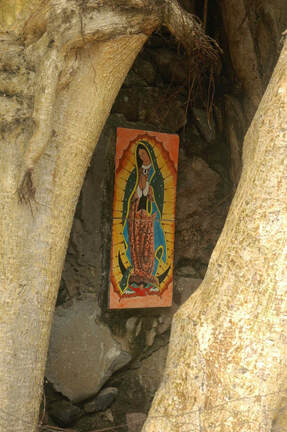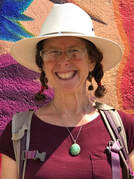|
The wake-up and get-ready music from the iglesia, the religious hub of the village, started at 4:30 a.m. I put on my warmest clothes and took my candle with me, leaving home a little after 5:00 The procession was scheduled to begin at 5:00 arriving at the church for Mass at 6:30. From previous years’ experience, I didn't rush to arrive at 5:00 sharp. I walked down the quiet road to the meeting place just past the town square: the altar for the Virgin of Guadalupe (La Guadalupana). It’s one of my favorite spots. Many nights I walk from my house down to the glassed in space built into the wall of someone’s house, taking a few minutes to view the various statues, images, flowers and usually, unlit candles. I send love and appreciation for Her, my divine mother who accompanies and rescues me many a dark moment. Upon arriving, I approached the altar, candles glowing as they do only at this time of year. I observed that everyone else did the same – paid homage to this beloved representation of the earth, feminine, divine. She is our caretaker, a mother, still recognized as Tonantzin a primordial deity that has nothing to do with Catholicism, although it is through that vehicle that she is largely acknowledged and honored by the masses. An unusually small group sat on ledges, walls and rocks, waiting quietly in small family groups. The padrinos of the event passed out atole and tamales to warm us up. The mayordomo from the church still hadn't arrived with the estandarte (banner with image of La Guadalupana painted upon the large cloth attached to a long pole). We couldn't begin without that so we continued waiting. I overheard some people talking about how our village is not having the normal 12 days of processions, unlike some other outlying villages which would be conducting them as usual. One woman commented, "It is because we're not allowed to have our Masses in the church that COVID isn't going away. What has happened to people's faith?" She went on to express her feeling that continuing with these traditions is important for the future generations. Noting the small crowd assembled, she lamented her concern that the youth of today won’t know the traditions, that the old ways will get lost, and that part of the problem is the outsiders. I was standing on the periphery of this conversation and found it intriguing that the comments about outsiders was not hidden at all from my ears. I wondered if I was not considered "one of them," or whether saying what was perceived and felt honestly was simply okay for them: nothing to be hidden; on the contrary, something to be heard. Either way, I appreciated knowing these true perceptions and opinions of at least one member of the community, and I imagine she is not alone in her view. In our village I see more and more outsiders - mostly Mexicans. If you’re wondering how Mexicans can be considered outsiders in Mexico, stay with me here. What are Outsiders? During the early, urgent months of COVID, a distinction was made in our village between the locals – those from this place, and those who have moved here. Regardless of cultural heritage, age, social standing, beliefs and practices – the second category, (myself included,) are all “avecinados”. For a brief time, announcements emanating from the loudspeaker at the mayor’s office were for the first an only time I know of, made in Spanish AND English, demonstrating realization of our presence and the particular type of impact we make in the community. The Impact of the “Outsiders” Why, in this pre-dawn conversation, were “Outsiders” mentioned as being to blame for the relatively tiny group gathered to conduct an age old ceremony? Here is my take on it. "Outsiders" represents the modern western world with all its consumerism, materialism, ways of thinking, speed, technology, virtual interaction (vs. in person in the moment with the world - the nature, beings, people in your midst). The influence of the Outsiders is increasingly causing separation from the natural world and how to be in harmonious conscious relationship with it – both “there” and in tiny villages throughout the world, thanks to internet and satellite TV. “Outsiders” and all they bring, dangle, model and profess, are attractive, seductive, and a distraction from the old ways, the traditions. I have been aware of and concerned about this since I moved here in 2006. I have noticed a distinct difference between what happens when I pass an elder on the street and when I pass a young person. An older person will look at me in the eyes and greet me, stranger or not. A youth will not look at me and will often pass without saying anything – regardless of whether they’re engaged in their smartphone at that moment.
Perhaps the lack of attendance in my village for the procession on December 12, 2020 is being attributed to the shift in focus and values taking place in the local families. Maybe it seems less important or necessary as more modern values take up more space and attention. That is the connection I can imagine between "Outsiders" and the loss of traditions for the upcoming generations in our village. The Procession Finally, the estandarte had arrived and people began kindling their long white candles from others' candles. I felt drawn to light mine from a specific elderly woman I didn't know, and somehow everyone else seemed to have the same inclination. A small line of us waited our turn with her candle. I admired all the female's young and old - familiarity with how to light a long wick from the middle, letting the overly long part become separated, falling like a dried umbilical cord, from the lower part of the wick. We were instructed to form two lines, while the mistress of ceremonies and volunteers carrying the seven various estandartes walked in the middle, leading us through the call and response singing, acknowledging the virgin of Guadalupe. I noticed that virtually no one was wearing a mask. Eventually we arrived to the churchyard, the estandartes delivered to the church and then everyone found a place to sit outside - on plastic chairs, the several white iron benches, or low stone walls that encircled ancient trees - for Mass. As always, people had carried their images of the virgin to the churchyard, each one propping their framed image or statue at the front of the ceremonial space, for blessing. I noticed several people brought buckets of water and left them in front as well. I don't know what this is about, but I wondered whether it was to make holy blessed water for use throughout the year. The sky began to lighten, revealing muted hues of gray, orange and purple. Looking around, I noticed more people had masks on in the churchyard than in the procession. I felt some relief about this. The Mass was coming to a close and with it, I knew, the customary shaking of hands with everyone around you, while bestowing wishes of peace. I felt concern about touching so many people's hands and so slipped out prior to the closing. Minutes later, while walking home, I heard the closing music of the Mass and knew it was complete. While I was walking in the procession with so many not wearing masks - and when I was seated in the churchyard with a larger crowd (around 150) - I watched how I could go either way regarding COVID and physical distance. One part of me could just be in the present, feel safe and enjoy the fresh pre-dawn air entering my lungs as I walked with a couple of feet distance between me and those ahead of and behind me. Another part of me felt unsafe and uncomfortable, feeling better when I put my mask on. Either way, it's like playing a game to me: deciding on and agreeing to the rules of whichever set of beliefs. Sometimes I’m not concerned, feel safe, and don’t put on my mask. Other times I feel unsafe and vulnerable and don my mask, feeling suddenly protected. Upon arriving home, I sprayed myself and the space around me with a disinfectant I'd made, and saged myself for double cleansing/clearing. Lighting a candle, I began my yoga and meditation practice as usual, picking up the "regular" part of my day, working with
...all with the help of the divine feminine, my mother, La Guadalupana.
0 Comments
Leave a Reply. |
Robin Rainbow GateI help people midlife and beyond to find their inner power, health and well being through slow, conscious living Ready to live Your True Life?Categories
All
|
|
|
Sign up here for
|
 Take Good Care of You Wellness Website and Contents by Robin Rainbow Gate is licensed under a Creative Commons Attribution-NoDerivatives 4.0 International License. |



